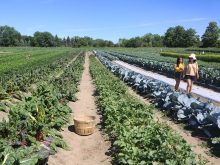No maximum residue limit for growth regulators have been established, creating roadblocks for exports
EDMONTON — Plant growth regulators probably have a role to play in western Canadian agriculture, say farmers familiar with the technology.
However, it might take some time to figure out exactly what that role is.
Producers attending FarmTech in Edmonton heard that plant growth regulators can boost harvested yields by as much as 20 percent under the right conditions.
Tom Eppinga, a grower from Bon Accord, Alta., said his experience with the products has been positive.
Eppinga applied Manipulator on CWRS wheat in 2013 and again in 2014.
He thinks the product will be a good fit for his farm, particularly under high fertility, high rainfall conditions.
“We really noticed that the crop stood up better, there was less disease and we had a really significant yield bump,” Eppinga said.
“The first time we used it, we kind of hit a home run…. We had a 20 percent yield bump…. The second time we used it, it was only maybe a five percent yield bump, but in a commercial setting that would still pay for itself. So the two times we used it, it was definitely profitable.”
When applied properly, registered PGR products reduce plant height and produce crops with stronger straw and better standability.
Read Also

New program aims to support plant-based exports to Asia
Understanding the preferences of consumers in Taiwan and how they differ from Indonesia or Malaysia isn’t easy for a small company in Saskatchewan.
Under high fertility and high moisture growing conditions, the products will reduce lodging losses and result in higher harvested yields than crops that have not been treated.
Improved standability also allows for more effective application of fungicides and reduces stress at harvest time.
PGR products are used in Europe and are particularly well suited to crops such as durum, barley and spring wheat.
A limited number of PGRs are registered in Canada.
Manipulator, which is gaining interest among prairie growers, is approved for use on spring wheat, winter wheat and durum, but not on barley.
In addition, maximum residue limits have yet to be established in some countries, most notably the United States.
In the absence of an established MRL, Canadian wheat or durum that has been treated with Manipulator and is destined for U.S. markets could run into regulatory hurdles or marketing roadblocks.
For that reason, Eppinga urged producers to check with grain companies about marketing issues before using any PGR products.
“We went into 2015 thinking that there was going to be no problem, said Eppinga.
“We talked to the big three grain merchants and they said it would be no problem, but then, come August, there was a bit of a pullback, so it was kind of good that it was a dry year and we didn’t end up using it.… Going forward, I’m going to make sure that I know where my markets are going to be before I use it.”
Greg Stamp from Enchant, Alta., offered similar advice, suggesting growers should always check with their grain buyers and ensure that contracts do not have restrictions related to PGRs.
He said efforts are underway to establish MRLs for Manipulator in the United States, but that process could take several months.
In the meantime, growers who use the product should make sure they know where their markets are and seek assurances from their grain buyers that their crops will be accepted.
In terms of functionality, Stamp said the products have proven to be a good fit for his farm, especially on irrigated acres. In addition to higher harvested yields, there is less stress on machines and machinery operators at harvest time.
Application and efficacy of fungicides are also improved because the crops are more upright and uniform.
“Basically I would say that if you’re in a high moisture and a high fertility situation, then the PGRs might be for you and if you’re growing a variety that is on the taller side or is a risk of lodging, then they (might be suitable) as well,” Stamp said.

















